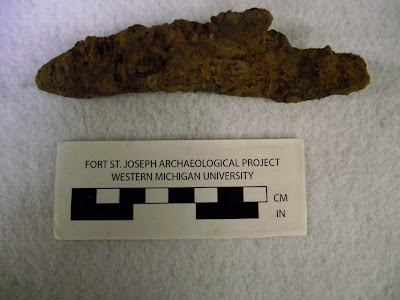 |
| Brittany style faience plate. (Photo by George Avery) |
My research began with a broad reading of pottery analysis in archaeology. I learned that it is primarily used for inferring chronological dates, food ways, and social status in societies. Ceramics, especially faience, are quite useful for finding dates. There are quite few records that indicate what years specific styles of faience were produced. With that knowledge we can deduce the earliest date that piece of pottery, and any other artifacts it was associated with, were deposited in the archaeological record. Even if we only find fragments of the pottery vessel we can know its form, like a plate, bowl, or jar. Once we know what kinds of vessel forms are associated with sites we can infer the types of foods that were eaten by the inhabitants. For example, if we find mostly bowls across a site we can infer that the people are eating more soups or gruels instead of fine cuts of meat that would normally be eaten on a plate. Knowing that information can also allow us to infer social status since meat, necessitating plates, is more often reserved for those of higher rank.
As my reading on the broader use of pottery analysis became redundant I narrowed my research to focus solely on the varieties of faience. While my understanding has become quite lengthy faience can be generalized as a French ceramic tradition beginning in the mid-17th century and ending in the late 18th century that consisted of a tin glazed earthenware with a white or light red body and white glaze. It is most often decorated with blue designs that range from simple lines to
floral arrangements. More rarely, it is adorned with other colors such as purple, brown, or green. Vessels in this style are referred to as polychrome faience whereas the others are aptly referred to as blue-on-white.
 |
| Faience sherds from St. Genevieve. (Photo by George Avery) |
As the semester is coming to a close now my excitement to begin my own analysis of the faience at Fort St. Joseph is mounting. My next step is to head back to Niles to view the collection of faience recovered over the years so I can begin designing proper research questions geared towards the goals of the Fort St. Joseph Archaeological Project. I hope you all have a wonderful Thanksgiving and I can’t wait to be back in Niles!
















